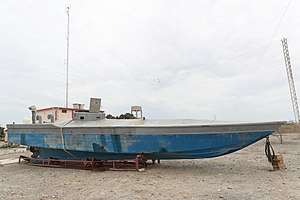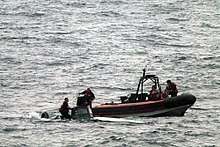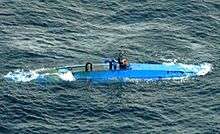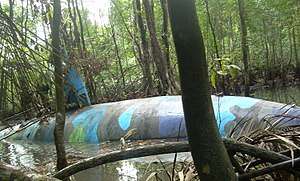Narco-submarine
A narco-submarine (also called drug sub) is a type of custom-made ocean-going self-propelled submersible vessel built by drug traffickers to smuggle drugs.[2] They are especially known to be used by Colombian drug cartel members to export cocaine from Colombia to Mexico, which is often then transported overland to the United States.[3][4] Concerns have also been raised that such vessels could be utilized for purposes of terrorism.[5] The capabilities of these crafts has noticeably increased (some are now capable of crossing the Atlantic Ocean); their operating places and circles have widened; and their numbers have taken a great jump.[6]

Newer narco-submarines are nearly fully submersible, designed specifically to be difficult to detect visually or by radar, sonar and infrared systems.[3]
Cargoes carried are typically several tons of cocaine. For example, in 2015 a cargo of 7.7 tonnes (17,000 lb) was seized on a semi-submersible which had been tracked by aircraft, the largest ever recorded.[7]
History
In 1980s, go-fast boats became the drug-smuggling vessel of choice in many parts of the world, though radar could detect these boats.[2] As radar coverage improved, Colombian drug cartels began to develop semi-submersibles in the 1990s to avoid radar detection.[8]
An unmanned 6.4 m (21 ft) submarine was found off Boca Raton, Florida in 1988. It was designed to be towed by a boat, and submerged by remote control. The sub was empty, but authorities suggested that it must have been designed for smuggling contraband, since the hatch could only be opened from the outside.[9]
2000s
In November 2006, a narco-submarine was seized 103 mi (166 km) southwest of Costa Rica carrying three tons of cocaine.[10] The U.S. Coast Guard dubbed it Bigfoot because they had heard rumors that such things existed, but none had actually been seen at that time.[3] In 2006, United States officials say they detected three vessels in total.[11] Experts estimated that 25 to 40 cocaine semi-subs departed from South America in 2007.[12]

By 2008, authorities were spotting an average of ten per month, but only one out of ten was intercepted.[11] In the first six months of 2008, the U.S. Coast Guard and U.S. Navy detected 42 drug subs heading north towards the United States and off the coast of Central America,[13] but few seizures resulted. The service estimated that 85 individual events would bring in about 544 tonnes cocaine by the end of 2008. On July 16, 2008, the Mexican Navy intercepted a 10 m-long narco-submarine travelling about 200 kilometres (110 nmi) southwest of Oaxaca. Mexican Navy Special Forces rappelled from a helicopter on to its deck and arrested four smugglers before they could scuttle their vessel. The vessel was found to be loaded with 5.3 tonnes of cocaine and was towed to Huatulco, Oaxaca, by a Mexican Navy patrol boat.[15][16][17][18][19] On September 12, 2008, the U.S. Coast Guard captured a semi-submersible about 563 kilometers (350 mi) west of Guatemala; it was carrying 7 tonnes of cocaine.[20][21] The 18 m long steel and fiberglass craft was detected by a U.S. Navy aircraft as part of Operation Panama Express and was intercepted by Coast Guard Law Enforcement Detachment 402 which was deployed aboard USS McInerney. Five days later, an 18 m semi-submersible was seized by the Coast Guard cutter Midgett about 322 km south of Guatemala.[22][23] Few other narco-submarines were seized as their crews scuttled them upon interception, with the vessels often sinking within a few minutes.[11][24]
In 2009, the United States detected as many as 60 narco-submarine related events, and it was calculated that they were moving as much as 330 tonnes of cocaine per year.[25] On June 1 and 2, 2009 the Colombian authorities seized three narco-submarines on the shores of the Pacific coast, one of them loaded with 1.5 tonnes of cocaine.[26] The Colombian navy had intercepted or discovered 33 narco-submarines by 2009.[8]
2010s
After the November 5, 2010 arrest of Harold Mauricio Poveda,[27] a key Mexican–Colombian link, it was suspected that FARC (the Revolutionary Armed Forces of Colombia) is behind the construction of narco-submarines and is collaborating with the Sinaloa Cartel to fund its armed activities.[28][29][30]
The largest recorded seizure took place in July 2015 when a cargo of 7.7 tonnes (17,000 lb) was seized on a semi-submersible which had been tracked by aircraft and interdicted by USCGC Stratton.[7][31]
On March 28, 2016 the US Coast Guard seized a semisubmersible about 300 miles west of Panama, carrying about 6 tons of cocaine with a street value of about $200 million.[32]
The US Coast Guard detained a semi-submersible on 12 November 2017 off the coast of Texas carrying 1.7 tonnes (3,800 lb) of cocaine,[33] and on 13 November the US Coast Guard located and seized another one off the coast of Panama. It was carrying 1.72 tonnes of cocaine.[34]
On 24 November, 2019, Spanish police apprehended a 20 m semi-submersible off Galicia, Spain containing 3,000 kg of cocaine.[35] A narco-submarine was captured by the Peruvian Navy on 8 December 2019 carrying over 2,000 kg of cocaine off of the coast of the Department of Piura in Peru.[1][36]
2020
By now, their suspected numbers are close to 1,000.[6]
Types of vessels
Costing up to two million dollars each to construct, submarines can move enough cocaine in a single trip to generate more than 100 million USD in illicit proceeds for the traffickers.[2][25]
Semi-submersible

Colombia's Pacific coastline, where muddy rivers loop into the ocean, has long been a smugglers' paradise. Behind the jagged cliffs that jut into the ocean is a vast jungle, laced with mangrove-fringed coves and thousands of miles of waterways, easy to use as clandestine shipyards.[37] A Colombian Navy Commander stated that it is most striking to notice the logistical capacity required of these criminals in order to take all the material into the heart of the jungle, including heavy equipment such as propulsion gear and generators.[38] Sometimes they are put together in pieces and then reassembled in other locations under the jungle canopy, in camps outfitted with sleeping quarters for workers. The narco-submarines can cost about $2 million USD and take upward of a year to build.[38] Despite the costs, some of the craft are intended for one-time use, being abandoned at sea after a successful delivery, given that their cargoes carry a street value of up to $400 million. On other seized craft however, officials found zinc bars used as sacrificial anodes, reducing corrosion on metal parts exposed to seawater.[39] As corrosion would not be a concern on a single trip but is a factor influencing long-term durability, this is a clear indication that multiple use was intended. This, in turn, opens up the question of any illicit return cargo, like weapons, that they might carry back to Colombia.
The design and manufacturing techniques employed in their construction have improved over time: the boats have become faster, more seaworthy, and of higher capacity than earlier models.[2] An 18 m (59 ft) long narco-submarine can reach speeds of 18 km/h (9.7 knots) and carry up to 10 tons of cocaine.[2] They are typically made of fiberglass, powered by a 225–260 kW diesel engine and manned by a crew of four. They have enough cargo space to carry two to ten tons of cocaine, carry large fuel tanks which give them a range of 3,200 km (1,700 nautical miles),[2] and are equipped with satellite navigation systems. There is no head (toilet), and accommodation is cramped.
Because much of its structure is fiberglass and it travels barely under the surface, the vessel is nearly impossible to detect via sonar or radar, and very difficult to spot visually. The newer models pipe their exhaust along the bottom of the hull to cool it before venting it, making the boat even less susceptible to infrared detection.[3] They are most easily spotted visually from the air, though even that is difficult as they are camouflaged with blue paint and produce almost no wake. They have ballast tanks to alter the vessel's buoyancy so that they ride low in the water.
Typical characteristics
These are the typical characteristics as stated by the U.S. Joint Interagency Task Force South:[38]
- Hull material: wood, fiberglass, or steel
- Length 12–24 m
- Freeboard 0.5 m
- Engines: single or twin diesel
- Fuel capacity: 5.6 cubic metres
- Range: 3200 kilometers
- Speed: 11 km/h or more
- Crew: 4
- Capacity 4–12 metric tons
- Control: human or remote
True submarines

Narco-submarines were considered by officials to be an oddity until 2000, when Colombian police discovered what was reported to be a half-built 36 m-long[40] true submarine in a warehouse outside Bogotá.[3][41] The double-hulled steel vessel could have traveled 3,700 kilometers, dived 100 m[40], and could have carried about 15 tonnes of cocaine.[40]
On 3 July 2010 the Ecuadorian authorities seized a fully functional, completely submersible diesel electric submarine in the jungles bordering Ecuador and Colombia.[4] It had a cylindrical fiberglass and Kevlar hull 31 m long, a 3 m conning tower with periscope, and air conditioning. The vessel had the capacity for about 10 tonnes of cargo, a crew of five or six people, the ability to fully submerge down to 20 m, and the capacity for long-range underwater operation.[4] Ecuadorean authorities seized the vessel before its maiden voyage.[42][43][44]
On 14 February 2011 another submarine was seized by the Colombian navy. The 31 m-long fiberglass and Kevlar vessel was found hidden in a jungle area in Timbiquí, in south-western Colombia. It was capable of travelling 9 m below water and it could carry four people and up to 8 tonnes of cargo.[45]
Torpedo
In August 2005, U.S. authorities discovered an unmanned semi-submersible in the Pacific Ocean.[46] What they discovered was a "torpedo"-style cargo container (instead of a full-featured self-propelled ship). It used a ballast tank (submersion control) to keep it at about 30 m under water while being towed by a boat. This particular "torpedo" was planned to be towed by a fishing vessel.[47] If a patrol ship is spotted, the "torpedo" cargo container is released. While still submerged, it was designed to automatically release a buoy concealed as a wooden log so as to be mistaken for marine debris by authorities. This log-buoy was equipped with a location transmitter system. This allowed the original towing vessel to retrieve the torpedo if the vessel and her crew were released by authorities. If the original vessel was detained, or otherwise unable to retrieve the cargo torpedo, the location transmission system also allowed for a second support fishing vessel to retrieve it and continue the narcotics delivery. Such a log-buoy was designed to be used as a last resort, as there would be inherent risks involved with the deployment of said buoy. Authorities could notice the sudden appearance of the "log", and investigate. Additionally, authorities could have possibly picked up signals from the buoy's transmission systems, and may have attempted to locate such signal(s). Therefore, crew involved in the towing would be instructed to operate under the guise of a normal fishing vessel. Indeed, the intention would be to ensure no suspicions were aroused, thus avoiding the risks associated with deploying the log-buoy, by avoiding deployment altogether.
The buoy contains a mechanism to temporarily raise and then lower its antenna and transmit its coordinates in encrypted form a few times per day. Encrypted codes were used in the event that a buoy was deployed, and authorities intercepted its signals. Such an encryption could, at a minimum, delay authorities in their attempt to reach the cargo, ostensibly allowing the narco-traffickers to reach it first. This system was adapted from existing buoys used on tuna fishing nets. One of its designers claims a 90% shipment delivery success rate, and stated that the "torpedo" development was heading towards a remote control feature using encrypted signals transmitted via satellite.[47]
Operations
Operators
Routes
The western Colombian shore topography is near ideal for transporting the cocaine produced in clandestine laboratories in nearby Nariño department. About a third of the 550 metric tonnes of cocaine coming out of Colombia each year leaves via the Pacific coast and a significant amount is being carried in semi-submersibles.[49] The U.S. Homeland Security estimates that drug submarines now account for 32 percent of all maritime cocaine flow between Latin America and the United States.[50]
While the subs are most frequently used from the Pacific coast of Colombia, they are showing up elsewhere as well. The Coast Guard says drug runners have devised a complete logistics system, with fishing boats stationed along the way to warn the crews against patrols and provide them with food and water and resorting to putting refueling vessels far offshore so drug-carrying boats can avoid coastal areas.[51] For traffickers, reaching Mexico is well worth the trouble, as a 9 metric tonne load can fetch nearly US$200 million wholesale. Fishermen hired specifically for the task are often at the controls, and those who complete the trip successfully are paid about US$3,000.[3][47]
Smugglers normally unload their cargo onto fast power boats for the final leg to shore and the semi-submersible is scuttled. None have been sighted unloading at North American ports or beaches. In 2006, a 10 metre long sub was found abandoned on the northern coast of Spain, where the authorities suspect the crew had unloaded a cargo of cocaine before fleeing.[52] In March 2006, the Calabrian Mafia ('Ndrangheta) ordered a shipment of 9 tonnes of cocaine to be transported by a narco-submarine from Colombia to Italy, but the vessel was discovered by the Colombian police while it was still under construction.[53]
During 2007, thirteen of the vessels were seized on Colombian dry land or stopped at sea by Colombian or U.S. patrol boats, more than in the previous fourteen years combined, but arrests are rare. When clandestine shipyards were discovered, workmen escaped into the jungle. In some instances semi-subs are towed behind other vessels and are scuttled if detected. Authorities are investigating reports that some semi-submersibles are unmanned and are operated remotely.
Countermeasures
Surveillance
In 2007, the U.S. Coast Guard was adjusting its underwater acoustic sensors to listen to a narco-submarine's engine over long distances.[54] As of 2019, the United States Coast Guard reported that it captures only about 11% of narco-submarine vessels.[55]
Legal
When semi-submersibles are stopped at sea, their crews usually scuttle them, sending both the boat and the cocaine to the bottom within minutes and leaving no evidence of trafficking. Until 2008, in accordance with maritime law, the crew was rescued and, if there was no physical evidence of wrongdoing, released without criminal charges. To address this legal loophole, the US Drug Trafficking Vessel Interdiction Act was enacted in September 2008, making it a "felony for those who knowingly or intentionally operate or embark in a self-propelled semi-submersible (SPSS) that is without nationality and that is or has navigated in international waters, with the intent to evade detection". The penalty is a prison term of up to twenty years in the U.S.[56]
The bill does not apply to flagged vessels (i.e., that have been registered with some nation). The bill grants extraterritorial jurisdiction over international waters, and also makes it illegal to lack relevant documents. Instead of an anti-narcotics operation turning into a rescue mission when the submarines are scuttled and sink, the crew can be arrested and charged.[57]
Some alleged narco-submarine smugglers are now facing criminal charges in the US for operating an unflagged semi-submersible.[58]
Colombia's Congress passed a law in June 2009, punishing the building of semi-submersible vessels with up to twelve years in prison, and transporting drugs in them with up to fourteen years in prison.[57]
National security issues related to torpedo style cargo containers, semi-submersible vessels, and submarines used for smuggling and/or terrorist activities were reviewed in an August 2012 article in Homeland Security Affairs.[59] Also presented are behaviors indicating shifts in methods of operating by drug traffickers and the corresponding risk to national security.
See also
References
- "Peruvian authorities seize narco-submarine carrying over a ton of cocaine". The Miami Herald. 13 December 2019. Retrieved 3 February 2020.
- SCHMIDT, MICHAEL S.; THOM SHANKER (10 September 2012). "Smugglers Go Under the Sea To Move Drugs". The New York Times. 9/10/12 N.Y. Times A1. p. 9/10/12 N.Y. Times A1.CS1 maint: location (link)
- Kushner, David (April 23, 2009). "Drug-Sub Culture". The New York Times. Retrieved 2009-04-25.
- Bajak, Frank (July 4, 2010). "Ecuadoreans, DEA seize drug-smuggling submarine". APF. Retrieved 2010-07-04.
- Estes, Adam Clark (2012-09-09). "The Feds Can't Catch the Cartels' Cocaine-Filled Submarines". The Atlantic. Retrieved 2020-02-06.
- Mizokami, Kyle (March 4, 2020). "Why Our Seas Are Suddenly Swimming With Drug-Running Narcosubs". Popular Mechanics. Retrieved March 4, 2020 – via Yahoo!.
- "US navy seizes submarine with seven tonnes of cocaine on board". The Guardian. Associated Press. 22 July 2015. Retrieved 29 April 2017.
- Booth, William; Juan Forero (June 6, 2009). "Plying the Pacific, Subs Surface as Key Tool of Drug Cartels". The Washington Post. Retrieved 2010-02-23.
- "Creative drug smugglers turn to submarines". UPI Archives. United Press International. 11 November 1988. Retrieved 3 May 2017.
- "Submarine with cocaine seized off Costa Rica". The Associated Press and Reuters. NBC News News. November 20, 2006. Retrieved 2018-06-18.
- "Drug-trafficking trends". The Economist. May 1, 2008. Retrieved 2010-02-19.
- "Narco subs pose new challenge for US coast guards". APF. May 9, 2008. Archived from the original on December 4, 2008. Retrieved 2010-02-19.
- Housley, Adam (May 2, 2008). "Drug subs". Fox News. Archived from the original on May 3, 2008. Retrieved 2010-02-23.
- "MÁS DE CINCO TONELADAS DE COCAÍNA TRAÍA EL MINISUBMARINO ASEGURADO POR LA ARMADA DE MÉXICO" (in Spanish). Mexican Navy. July 18, 2008. Archived from the original on July 14, 2011. Retrieved 2010-02-23.
- "Mexico captures submarine loaded with drugs". Reuters. Canada News. July 17, 2008.
- La Mala, Maegan (July 17, 2008). "The Narco Submarine". VivirLatino. Archived from the original on March 2, 2009. Retrieved 2010-02-23.
- "Mexican navy seizes cocaine sub". BBC News. 18 July 2008. Retrieved 2010-02-23.
- "Drug cartels using submarines to smuggle cocaine". CTV News - Canada. July 19, 2008. Retrieved 2010-02-23.
- "Coast Guard seizes $8.4 million worth of cocaine". CNN News. September 14, 2008. Retrieved 2008-09-15.
- SILVESTRINI, ELAINE (September 13, 2008). "Drug-Toting Semi-Sub Nabbed In Tampa-Based Probe". The Tampa Tribune. Retrieved 2008-09-15.
- Meserve, Jeanne (September 19, 2008). "Cocaine smugglers turn to submarines, feds say". CNN News. Retrieved 2008-09-20.
- Videos and images of these two seizures are available at the U.S. Coast Guard web site:
- Acosta, Luis Jaime; Hugh Bronstein (January 3, 2008). "Another cocaine-laden submarine sinks off Colombia". Reuters. Retrieved 2010-02-19.
- Joint Interagency Task Force. USA Southern Command, ed. (19 June 2012), Written Statement of Rear Admiral Charles Michel, Director[,] Joint Interagency Task Force South (JIATF-SOUTH) before the Subcommittee on Border and Maritime Security [of the] House Committee on Homeland Security (PDF), Washington D.C.: JUSTF.org, archived from the original (PDF) on November 2, 2013, retrieved 2012-06-20
- "1.5 Tons of Cocaine Seized in Colombia". Latin American Herald Tribune. Retrieved 2010-02-23.
- The mafia rabbit (November 25, 2008)
- Detienen al Conejo, proveedor de El Barbas El Universal. November 5, 2010 (in Spanish)
- "Insurgent submersibles". Jane's Information Group. 16 June 2008. Retrieved 2010-02-26.
- Stavridis, James, ed. (2009), "U.S. Southern Command 2009 Posture Statement" (PDF), Report to the 111th Congress - 2009, U.S. Navy, retrieved 2010-02-26
- Almasy, Steve (7 August 2015). "Coast Guard seizes $181 million in cocaine on sub". CNN News. Retrieved 2015-08-10.
- US Coast Guard intercepts vessel carrying cocaine worth $200m. BBC News, 29 March 2016.
- U.S. Coast Guard intercepts semi-submersible vessel packed with 3,800 pounds of cocaine. USA Today. 11 December 2017.
- Narco subs: Texas mobilises to stem invasion of narcotic carrying submarines. Jamie Seidel, News Com Australia. 22 December 2017.
- Jones, Sam (November 27, 2019). "Cocaine seized from 'narco-submarine' in Spain was likely headed for UK" – via www.theguardian.com.
- "Interceptaron en Perú un narcosubmarino cargado con dos toneladas de droga". Infobae (in Spanish). 8 December 2019. Retrieved 3 February 2020.
- Kraul, Chris (November 6, 2007). "Drug traffickers use submersibles to ferry narcotics". Los Angeles Times. Retrieved 2010-02-19.
- "Self-Propelled Semi-Submersible (SPSS)" (PDF), Self-Propelled Semi-Submersible (SPSS) - Fact Sheet, USA: Joint Interagency Task Force South, 2008, retrieved 2010-02-19
- "Inside", Inside Cocaine Submarines, USA: National Geographic Channel, 2009
- El 'narcosubmarino' Colombiano. El Pais. 11 September 2000.
- "Drug submarine found in Colombia". BBC News. 7 September 2000. Retrieved 2009-11-30.
- "Ecuador authorities seize drug-smuggling sub". CNN News. July 3, 2010. Retrieved 2010-07-04.
- "DEA Intel Aids In Seizure of Fully-Operational Narco Submarine In Ecuador". USA Drug Enforcement Administration. DEA Public Affairs. July 3, 2010. Archived from the original on July 9, 2010. Retrieved July 6, 2010.
- Lewis Page (6 July 2010). "First true submarine captured from American drug smugglers". The Register. Retrieved 25 January 2011.
- "Sophisticated drug submarine seized in Colombia". BBC News. 14 February 2011. Retrieved 2011-02-15.
- "Narco-Submarines: Applying Advanced Technologies to Drug Smuggling - Small Wars Journal". Retrieved 29 April 2017.
- "Video documentary: Narco Submarine Technology" (in Spanish and English). November 15, 2009. Archived from the original on 2011-07-17. Retrieved 2010-03-08.
- Dalby, Chris (2019-11-29). "Legend of Colombia's Narco-Subs Reaching Europe Becomes Reality". InSight Crime. Retrieved 2020-02-06.
- "The War In The Pacific". Strategy Page. July 7, 2008. Retrieved 2010-02-19.
- Hall, Kevin G. (July 18, 2008). "At $2 million each, subs become the drug transport of choice". McClatchy Newspapers. Archived from the original on May 4, 2009. Retrieved 2010-02-19.
- Meserve, Jeanne; Mike M. Ahlers (March 20, 2008). "Coast Guard hunts drug-running semi-subs". CNN News. Retrieved 2010-02-23.
- "Spanish police find 'drugs' sub". BBC News. 14 August 2006. Retrieved 2010-02-23.
- PISA, NICK (30 Mar 2006). "Drug cops foil mafia plot to smuggle $870m of cocaine by submarine". CYBER DIVER News Network. Retrieved 2010-02-23.
- "Run Silent, Run Drugs: The Cocaine Sub Fleet". ABC News. December 20, 2007. Archived from the original on May 24, 2009. Retrieved 2010-02-23.
- "Watch the US Coast Guard board a narco-sub carrying 17,000 pounds of cocaine". CNN. 12 July 2019. Retrieved 2020-02-06.
- U.S. Congress (Jul 28, 2008). "S. 3351: Drug Trafficking Interdiction Assistance Act of 2008". GovTrack. Retrieved 2010-02-23.
- McDermott, Jereny (June 20, 2009). "Colombia out to sink cocaine barons by banning 'drug subs'". The Scottsman. Archived from the original on June 23, 2009. Retrieved 2009-06-20.
- Ansari, Azadeh (January 14, 2009). "Smugglers sink 'drug subs,' but not feds' case". CNN News. Retrieved 2010-02-23.
- Lichtenwald, Terrance G.; Steinhour, Mara H.; Perri, Frank S. (August 2012). "A maritime threat assessment of sea based criminal organizations and terrorist operations". Homeland Security Affairs. Retrieved 2012-08-12.
Further reading
- "Ayer Médico, Hoy Narco – El Mexicano que Quizo ser Pablo Escobar" (In Spanish) Author: Miguel Angel Montoya. Publisher: Oveja Negra. ISBN 978-958-06-1092-2. Biography, includes one chapter on the narco-submarine and narco torpedo development.
External links
| Wikimedia Commons has media related to Smuggling submarines. |
- Drug Submarines' Culture
- Does ‘Smuggler’s Corridor’ Now Extend to South America?
- Authorities in Awe of Drug Runners' Jungle-Built, Kevlar-Coated Supersubs
- Anatomy of a narco-submarine, El Pais (In Spanish)
- Videos
- Colombian traffickers moving drugs in submarines
- US Coast Guard intercepts drug running submarine
- Rep Poe Worried About Drug Running Submarines
- Photo gallery